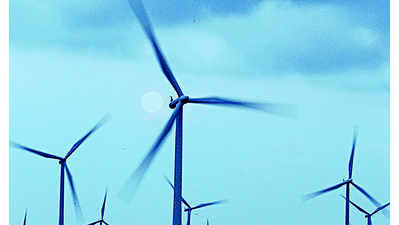- News
- City News
- hubballi News
- Windmills a threat to birds, animals in Ch’durga, Gadag
Trending
This story is from February 21, 2022
Windmills a threat to birds, animals in Ch’durga, Gadag
A scientific report, published on www.nature.com on January 25, has revealed that the fatality rate of birds is increasing in Chitradurga and Gadag districts where a large number of windmills are installed.

Hubballi: A scientific report, published on www.nature.com on January 25, has revealed that the fatality rate of birds is increasing in Chitradurga and Gadag districts where a large number of windmills are installed.
Wind turbines, an alternative and clean-energy source, have become a threat to birds as they collide with the turbine blades in some regions .
Bird richness is found more in the control sites (CS) than in wind turbine sites (WS). The fatalities are due to the collision of birds with the rotor blade of the turbine. The fatalities are determined by the composition and diversity of animals in the area, or if a wind farm is along the migratory flyway of birds.
Honnavalli N Kumara, principal scientist, Salim Ali Centre for Ornithology and Natural History, (Sacon), Coimbatore, Tamil Nadu, told TOI that other scientists including S Babu, G Babu Rao, Santanu Mahato, Malyasri Bhattacharya, Nitin Venkatesh Ranga Rao, D Tamiliniyan, Harif Parengal, D Deepak, Athira Balakrishnan and Mahesh Bilaskar were involved in the study.
He further said, “Blackbuck, Chinkara, Golden Jackal and Jungle Cat were less likely to occupy sites with a high number of WSs. The study indicates that certain bird and mammal species avoided wind turbine dominated sites, affecting their distribution pattern. This is of concern to the management of the forested areas with wind turbines. We have raised conservation issues and mitigating measures to overcome the negative effects of wind turbines on animals, in the report.”
Sharing the results, Kumara said that 144 and 124 days were spent on carcass searches in Chitradurga and Gadag districts, respectively. “We recorded one bird carcass each in Challkere WS, Jogimatti WS, Kelur WS, and Kappatagudda WS, and recorded one bat carcass each in Kappatagudda WS and Challkere WS, and four in Jogimatti WS. The carcasses were recorded between 2 and 118m distances from the wind turbine base. The mean annual birds and bats fatality rate per wind turbine was 0.26 animals per year. The Chitradurga with 0.33/wind turbine/year, had a higher fatality rate than in Gadag with 0.20/wind turbine/year,” he stated.
Harshavardhan Sheelavant, a bird enthusiast in Dharwad, stressed on need of an amicable solution as wind is a clean energy source.
Wind turbines, an alternative and clean-energy source, have become a threat to birds as they collide with the turbine blades in some regions .
Bird richness is found more in the control sites (CS) than in wind turbine sites (WS). The fatalities are due to the collision of birds with the rotor blade of the turbine. The fatalities are determined by the composition and diversity of animals in the area, or if a wind farm is along the migratory flyway of birds.
Honnavalli N Kumara, principal scientist, Salim Ali Centre for Ornithology and Natural History, (Sacon), Coimbatore, Tamil Nadu, told TOI that other scientists including S Babu, G Babu Rao, Santanu Mahato, Malyasri Bhattacharya, Nitin Venkatesh Ranga Rao, D Tamiliniyan, Harif Parengal, D Deepak, Athira Balakrishnan and Mahesh Bilaskar were involved in the study.
“We assessed the responses of birds to the wind turbines in central Karnataka, from January 2016 to May 2018, using carcass searches to quantify animal collisions (birds and bats), fixed radius point count for bird population parameters, and an occupancy framework for assessing the factor that determines the spatial occurrence of terrestrial mammals. The mean annual animal fatality rate per turbine was 0.26/year. Species richness, abundance and unique species of birds were relatively higher in control sites over wind turbine sites,” he said.
He further said, “Blackbuck, Chinkara, Golden Jackal and Jungle Cat were less likely to occupy sites with a high number of WSs. The study indicates that certain bird and mammal species avoided wind turbine dominated sites, affecting their distribution pattern. This is of concern to the management of the forested areas with wind turbines. We have raised conservation issues and mitigating measures to overcome the negative effects of wind turbines on animals, in the report.”
Sharing the results, Kumara said that 144 and 124 days were spent on carcass searches in Chitradurga and Gadag districts, respectively. “We recorded one bird carcass each in Challkere WS, Jogimatti WS, Kelur WS, and Kappatagudda WS, and recorded one bat carcass each in Kappatagudda WS and Challkere WS, and four in Jogimatti WS. The carcasses were recorded between 2 and 118m distances from the wind turbine base. The mean annual birds and bats fatality rate per wind turbine was 0.26 animals per year. The Chitradurga with 0.33/wind turbine/year, had a higher fatality rate than in Gadag with 0.20/wind turbine/year,” he stated.
Harshavardhan Sheelavant, a bird enthusiast in Dharwad, stressed on need of an amicable solution as wind is a clean energy source.
End of Article
FOLLOW US ON SOCIAL MEDIA










